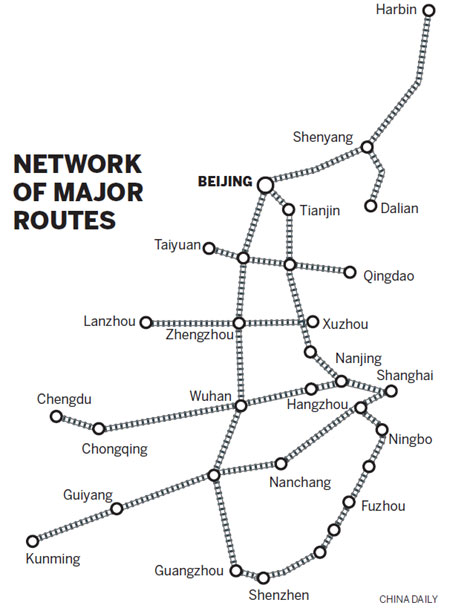Major lines for high-speed rail 'on track'
Updated: 2012-12-26 07:12
By Xin Dingding (China Daily)
|
||||||||
A network of high-speed lines, linking secondary routes to major ones, is on track to be completed by 2015, an official said a day before the first train departs on the world's longest high-speed line on Wednesday.
The 2,298-km line will connect Beijing and Guangzhou, capital of Guangdong province. Trains will hurtle along the track at 300 km per hour.
The country's high-speed railway network will reach 50,000 km by 2020, with four north-south and four east-west main lines as the major routes.
The Beijing-Guangzhou line is one of the main north-south routes. Another major route, the Beijing-Shanghai line, opened in June 2011.
Zhao Chunlei, deputy head of the transport bureau of the Ministry of Railways, said that the other lines are under construction but all will be completed by 2015.
Though the construction of high-speed lines slowed after a deadly train accident in July 2011 that killed 40 people, he described the current pace of construction as "quite fast".
Once the Beijing-Guangzhou line opens on Wednesday, the length of high-speed lines will reach 9,349 km, according to the ministry.
The past 12 months saw some 3,000 km of high-speed lines put into operation.
"The pace (of railway construction) is in accordance with the economy. Also, transport infrastructure should be built in advance," Zhao said.
After the 2011 crash in Wenzhou, the ministry conducted a comprehensive safety review of all projects under construction.
Train speeds were slowed from 350 km/h to 300 km/h and most projects were suspended.
The opening of the Beijing-Guangzhou line was pushed back by a year.
Wang Mengshu, deputy chief engineer at China Railway Tunnel Group, said the situation now is much better.
Many suspended projects have resumed construction, such as the link between Xi'an and Chengdu, he said.
The Ministry of Railways has also secured next year's investment of 600 billion yuan ($96 billion) for rail infrastructure, he said.
But some projects are still suspended, such as the Zhengzhou-Chongqing and Beijing-Zhangjiakou lines, he added.
"High-speed rail construction needs government funding. The loans the ministry borrowed have accumulated to nearly 4 trillion yuan so far, and each year the ministry needs to pay 80 billion yuan in interest", he said.
Besides the construction, Zhao said he believes high-speed trains could again hit speeds of 350 km/h in the future.
But he stressed that safety is the biggest priority and this could even mean reducing speed on some lines.
Trains that run at 200 km/h on the Harbin-Dalian railway in freezing temperatures could be slowed to 120 km/h or slower, if necessary. "Even suspending operations on that line is possible," he said.
Zhou Li, head of the ministry's science and technology department, said that the ministry has developed a full range of effective measures to manage safety.
xindingding@chinadaily.com.cn

(China Daily 12/26/2012 page1)

 Relief reaches isolated village
Relief reaches isolated village
 Rainfall poses new threats to quake-hit region
Rainfall poses new threats to quake-hit region
 Funerals begin for Boston bombing victims
Funerals begin for Boston bombing victims
 Quake takeaway from China's Air Force
Quake takeaway from China's Air Force
 Obama celebrates young inventors at science fair
Obama celebrates young inventors at science fair
 Earth Day marked around the world
Earth Day marked around the world
 Volunteer team helping students find sense of normalcy
Volunteer team helping students find sense of normalcy
 Ethnic groups quick to join rescue efforts
Ethnic groups quick to join rescue efforts
Most Viewed
Editor's Picks

|

|

|

|

|

|
Today's Top News
Health new priority for quake zone
Xi meets US top military officer
Japan's boats driven out of Diaoyu
China mulls online shopping legislation
Bird flu death toll rises to 22
Putin appoints new ambassador to China
Japanese ships blocked from Diaoyu Islands
Inspired by Guan, more Chinese pick up golf
US Weekly

|

|






